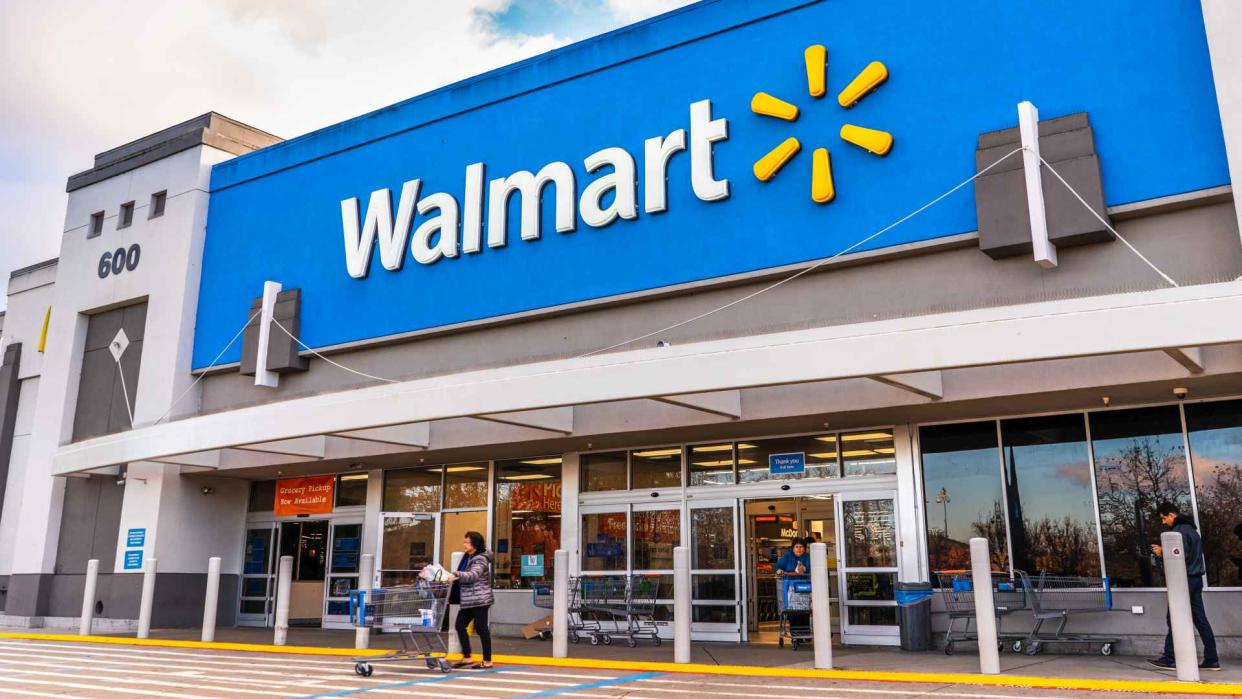How Walmart and Other Big-Name Stores Get You To Spend More Money

Perhaps the biggest reason that Walmart is so attractive — and successful — is that they tout mighty savings opportunities. The chain with over 10,500 locations hosts frequent sales, a sweeping clearance section and has their own version of Amazon Prime with Walmart+. But make no mistake: Walmart has a bottom line. They need consumer dollars and they have entire marketing teams devoted to making us spend, even if it means handing over cash on stuff that we weren’t planning on buying.
Costco’s Best Deals? Employee Reveals 10 Standout Buys for Your Money
More: How To Build Your Savings From Scratch
And it’s not just Walmart cooking up ways to make shoppers spend more — it’s every other big-box retailer. Some of the ways that these megastores incentivize mega spending, is, ironically, by offering up legitimately budget-friendly services. Take, for instance, Walmart’s free return policy. That’s not just them being nice; that’s them luring you into buying something in part because you know you can return it without the hassle of an added fee. Keep reading to learn about how these stores encourage you to spend more.
Free, No-Hassle Returns Add Up
Once you buy something, are you really going to return it? Maybe. Retailers are cleverly banking on you not. According to a 2018 NPR/Marist poll, 91% of American online shoppers claimed that they “only rarely” or “never” return things they buy online.
“The easy return policy at Walmart motivates customers to spend more,” said Sue Hirst, co-founder of CFO On-Call. “This perk encourages customers to shop more. According to research, easy and lengthy periods of return helps stores to increase sales.”
And the list goes on. Here’s some other ways that Walmart and competitors like Target and Costco lure consumers into being loyal customers–and (hopefully!) overspending.
Take Our Poll: Who Has Given You the Best Money Advice You Have Ever Received?
Their Tagline Convinces You That You Won’t Spend a Fortune
“Everyday Low Prices” — the basis of Walmart’s business model — has quite a lovely ring to it, and draws in quite a profit.
“Walmart constantly reminds consumers that they have low prices,” said Paul Sundin, a CPA, tax strategist and CEO of Emparion. “Walmart has been promoting low pricing for decades to attract customers. People want to save, so they’ll go for low prices. But what happens is they get too caught up with how cheap the items are; they want to buy more.”
They Place Essential Grocery Items Toward the Back or Far Sides of the Store
Ever notice how when you pop into a Walmart or Target for essential groceries you have to walk through a sea of other products and displays to get there? That’s no accident.
“One of the tactics I see brands with a grocery segment use all of the time is to locate staples like bread, milk and eggs far from the store entrance,” said Benjamin Sweeney, a business development and marketing strategist with ClydeBank Media who has worked on store-level merchandising. “It is counterintuitive: Staples should be easy to grab and located conveniently near the door, right? But, by putting staples far from the entrance, these brands force shoppers to walk past a greater number of displays while heading toward the items they came to purchase.”
‘BOGO’ Is a Consumer Psychology Hack
Another common incentive is “Buy One, Get One Free,” or BOGO. Who wouldn’t want to buy something and get an additional product at absolutely no cost? That’s your consumer brain working against you.
“Big-box retailers often use what it called psychology hacks to convert more sales: Walmart is notorious for using the BOGO sale hack to increase profit, especially when it comes to their clothing and accessories,” said Kristin Uptain, marketing manager of Redde Payments. “The BOGO discount fools the customer’s perception into believing they are getting a better deal.
“For example a ‘buy one, get one free’ would make anyone think they can have two for the price of one,” Uptain continued. “But in reality, this pushes you to spend more, boosting Walmart’s sales each time. Walmart already has a standard sale, this is the sale that their items are set to regardless of the time of year. For example, Walmart’s standard sale is a 50% off discount on a pair of $40 jeans. This sale runs whenever a special discount isn’t applied. The $40 jeans cost the seller only $10. So with a sale like this, the seller will profit $10 if they are 50% off ($40/2 = $20. $20 – $10 = $10).”
When the BOGO model is applied, Walmart will earn more profit than they would have if they ran their standard 50% off sale, Uptain said. “You can see that each pair of jeans cost the seller $10, so for two pairs the seller’s cost is $20. But with a ‘buy one get one free’ sale, the customer would need to purchase one pair of jeans at full price to get the second one for free. This means Walmart will profit $20 (after their wholesale purchase price) on this sale which is two times what they would have made on their standard sale. They convince the customer to buy more which allows Walmart to make more per transaction then they would have otherwise.”
They Invite Brands To Use Their Stores As a Walk-In Advertisement
Ever walked into a store and thought your favorite brand of cereal has bought the business? This too, is no accident.
“Basically, stores invite suppliers and manufacturers to come and actively advertise their products in-store,” said Swati Chalumuri, a personal finance expert and founder, HearMeFolks.com. “Known as merchandisers, these sales representatives pull no punches taking over entire aisles, offering big discounts and giving out freebies. Such grand displays and ‘saving’ opportunities are hard to ignore and you end up buying impulsively or getting bigger quantities than you normally do.”
Drown Out the Noise By Making a List
Walmart and other big-box retailers invest a lot of money into getting you to spend yours. But you can easily dodge their marketing ploys. All you need to do is make a budget and stick to it by having a list of needed items.
“Savvy shoppers create a list and a budget and they stick to both,” said Sweeney.
It’s such a simple way to elude sophisticated marketing schemes, but it works — even or especially when you’re in line at checkout staring down those all-too-tempting candies and snacks.
More From GOBankingRates
This article originally appeared on GOBankingRates.com: How Walmart and Other Big-Name Stores Get You To Spend More Money






